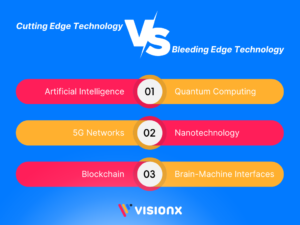Technology stands as a catalyst for metamorphosis in a world constantly redefining itself. Pioneering innovations have revolutionized human experiences and unlocked solutions to longstanding problems. These ground breaking technologies can be classified into “cutting edge” and “bleeding edge.” This article delves into their distinctions, exploring how these technologies shape industries and push potential human boundaries.

Unraveling Cutting-Edge Technology:
Cutting-edge technology is synonymous with the newest and most advanced technology available. It focuses on enhancing and improving existing systems, processes, and products. Examples include artificial intelligence, virtual reality, blockchain, and 5G networks, all of which have the potential to revolutionize industries such as healthcare, finance, manufacturing, and entertainment.
Cutting-edge technology is characterized by its problem-solving abilities, introducing solutions that were once considered impossible. Furthermore, it embraces scalability, ensuring adaptability and expansion to accommodate society’s evolving needs.
Venturing into Bleeding-Edge Technology:
On the other hand, Bleeding-edge technology is so innovative and experimental that its effectiveness still needs to be tested. Often pioneered by startups, researchers, and small teams of innovators, bleeding-edge technology has the potential to transform industries and redefine the world, albeit with substantial risk. Examples include quantum computing, nanotechnology, and brain-machine interfaces, which are still in their infancy.
The primary challenge associated with bleeding-edge technology is the high development cost and the uncertainty of success. These technologies demand significant investment and time without guaranteeing market triumph.
Cutting-Edge vs Bleeding-Edge Technology: Differences
The critical differentiator between cutting-edge and bleeding-edge technology lies in their maturity levels. Cutting-edge technology has been tested and proven effective, while bleeding-edge technology remains in developmental infancy.
Risk levels also vary; cutting-edge technology presents lower risks due to its proven effectiveness, whereas bleeding-edge technology bears higher stakes as it remains untested. Moreover, advanced technology enjoys broader adoption and acceptance than its bleeding-edge counterpart.
Benefits and Challenges of Cutting-Edge Technology:
While cutting-edge technology promises significant benefits across industries, such as automation and enhanced decision-making, it also poses challenges. High development and adoption costs, the need for continuous training and education, and the risk of obsolescence are among the most prominent obstacles.
Similarly, bleeding-edge technology offers unique benefits, such as solving complex problems and assisting people with disabilities. However, its challenges include high risk and uncertainty, lack of standards and regulations, and scalability limitations.
Spotlighting Cutting-Edge and Bleeding-Edge Technology Examples:
Cutting-edge technology:
- Artificial Intelligence: AI is revolutionizing various industries with its automation and decision-making capabilities.
- 5G Networks: These advanced wireless networks offer faster speeds, lower latency, and greater capacity than previous generations.
- Blockchain: This technology offers secure and transparent transactions, transforming industries like finance, banking, healthcare, and supply chain management.
Bleeding-edge technology:
- Quantum Computing: This revolutionary technology uses qubits to solve complex problems that traditional computers cannot.
- Nanotechnology: By manipulating matter at the nanoscale, nanotechnology can transform industries like healthcare, energy, manufacturing, and electronics.
- Brain-Machine Interfaces: These interfaces directly connect the brain to computers or devices, offering potential benefits to people with disabilities, although they are still in early development.
Conclusion:
Both cutting-edge and bleeding-edge technologies have the potential to reshape industries and redefine the world. By understanding their differences and the benefits and challenges they present, we can harness their power to shape a better future for all.
VisionX is a hypothetical cutting-edge technology company that offers a range of solutions to help businesses across various industries improve their operations, enhance customer experiences, and drive innovation. By leveraging the power of artificial intelligence, machine learning, computer vision, and other advanced technologies, VisionX can transform how organizations approach problem-solving and decision-making.
